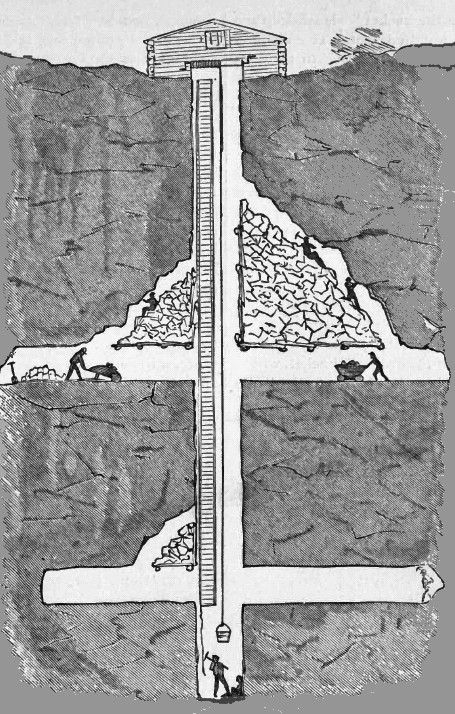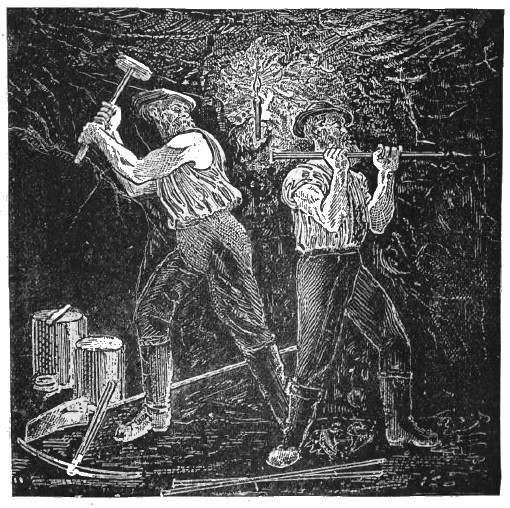The Lake Superior Copper Region. This region was discovered by Douglas Houghton in 1830. It has since that time produced more native copper than all other localities put together. In fact it has become one of the most famous copper producing districts of the world. The rocks, known as the Keweenaw series, consist of inter-bedded lava flows, sandstones and conglomerates. The conglomerates consist of rounded fragments of a reddish quartz porphyry of igneous origin The Lake Superior copper deposits are in the Keweenawan, the upper series of the Algonkian. The Keweenawan series consists of interbedded basic lava flows, sandstones, and conglomerates, intruded by acidic and basic porphyries. A fault strikes northeastward along Keweenaw Point near its center. Southeast of the fault the copper-bearing beds are probably covered by the nearly horizontal Eastern (Cambrian) sandstone. Northwest of it the Keweenawan beds dip northwest at angles of 40 to 20 or less. This series of beds, whose entire thickness may be from 25,000 to 30,000 feet, dips westward from 35 to 70 degrees, being overlain conformably on the west by sediments, while on the east they are faulted up against the horizontal Potsdam sandstones. These beds form a belt 2 to 6 miles wide, which extends from Houghton to the end of the Keweenaw peninsula, and rises as a ridge from 400 to 800 feet above the lake.
Although these deposits were worked in prehistoric times, as evidenced by copper implements and ornaments found in the mines, the famous Calumet and Hecla Mine was not opened up until 1846. In 1847 Michigan produced 213 long tons of the total United States production of 300 tons of copper. Since 1863 the annual output has exceeded 1000 tons and gradually and steadily increased up to 1905, when it reached 230,287,992 pounds. Since that year it has only exceeded it once, and has usually been less. The copper ores from this district, which are known as Lake ores, are all of low grade, but the deposits are of great extent and rather uniform mineralization, and this fact, together with the possibility of high concentration and low cost of refining, makes it possible to work these low-grade deposits at a profit. The richest copper ore now mined contains under 1.5 per cent of copper, while the poorest runs but little over .5 per cent. The crushed and concentrated material carries about 65 per cent copper, and this passes through a combined smelting and refining process. That portion of the copper which contains enough silver to make its recovery profitable, and some which runs too high in impurities for certain uses, is refined electrolytically. The amount so treated has been lessened, owing to a recent demand for copper carrying arsenic. The average recovery of silver per ton of rock mined was .2 fine ounce.
The copper deposits are in the main broad tabular bodies that strike and dip with the beds. The principal productive belt, which is in the Middle Keweenawan, extends from a point near Rockland, in Ontonagon County, northeastward to a point near Eagle River, a distance of about 70 miles. Numerous veins cut across the lodes. Nearly all the copper now mined occurs as native metal, although some copper as arsenides is obtained from veins that cross the lava beds in the Ahmeek mine. The copper content of the ore is low, ranging at present from about 0.6 to 2 per cent. A little native silver occurs with the copper; in the ore now mined it is almost negligible.
The principal gangue minerals are calcite, quartz, chlorite (delessite), prehnite, and laumontite, but considerable quantities of analcite, orthoclase, thomsonite, apophyllite, natrolite, and other zeolites are present, with many other minerals. The copper of the bedded deposits replaces the conglomerates and amygdaloids, fills amygdules and other openings in them, and cements small fissures in the trap series. At present the amygdaloidal deposits supply about twice as much ore as the comglomerates. The latter are mined extensively in the vicinity of Calumet. The amygdaloidal and conglomerate deposits extend great distances along the strike; the Kearsarge lode is mined almost without break for 14 miles, and other lodes are mined for 2 miles or more along their strike. They have been followed down the dip more than 1.5 miles, or about 1 mile below the surface.
Copper is found at many stratigraphic horizons in the amygdaloids. Some of the lava flows are 100 feet thick or even thicker. At some places the amygdaloidal ore is at the top, at others at the bottom of the flow. In general the productive amygdaloids are mined for a width of 30 or 40 feet. At some places the amygdaloids carry copper for a width of only 3 or 4 feet; at such places they are generally unprofitable. Although a number of conglomerate beds contain small amounts of copper, only two conglomerates, the Allouez and the Calumet, are workable. One of these, the Calumet, is the mainstay of the Calumet & Hecla Co., the greatest copper producer in the region. This conglomerate dips 39 NW. at the surface and is followed down the dip 8,100 feet, to a vertical depth of 4,748 feet. The conglomerate lode is 13 feet wide at the surface and 20 feet wide in the deep workings. The upper half of the bed is richer than the lower half. The copper content of this conglomerate was about 4 per cent, near the surface, but a mile vertically below the surface it is only 1 to 1.5 per cent.
The copper ores were probably deposited during the period of extrusion of the lavas and before the series was tilted. They are probably related genetically to intruding igneous rocks. Zeolitic copper ores are found associated with basic lavas in New Jersey and at other places but none of them have yielded much copper. Deposits of native copper occurring in basic volcanic rocks, especially those of basaltic character, form a widespread type. They are not strictly speaking the work of circulating waters, although the minerals are precipitated from solution. A noteworthy fact is the constant association of the copper with zeolites, calcite, quartz, epidote, etc., the ore and gangue minerals either filling the gas cavities or replacing the rock. The igneous rocks are regarded by many as the source of the copper, analysis often showing a small percentage of this metal, and its concentration seems to be associated with the development of the zeolites, so that a theory proving the origin of one must include the other. It is therefore believed by some that the magmas erupted either on the ocean floor, or in bodies of fresh water, absorbed the water of these on cooling, and that this on mixing with magmatic exhalations broke up the copper silicate present, changing it to copper chloride. Iron silicates were similarly affected. These chlorides were then decomposed by silicates or even carbonates of lime, yielding native copper, ferric oxide and calcium chloride.The ore is native copper occasionally associated with native silver. It occurs: (1) As a cement in the conglomerate, or replacing the conglomerate; (2) as a filling in the amygdules of the lava beds; and (3) as masses of irregular and often large size in veins with calcite and zeolitic gangue. The original lava flows was the home of small percentages of copper, and while these basaltic rocks were still heated they absorbed sea waters charged with sodium chloride. Meteoric waters transferred the sodium chloride downward and in their downward transition they dissolved the copper as copper chloride. Reactions between the original minerals of the volcanics and the copper solution gave rise to native copper, calcium chloride and soduim silicates.
The following assemblage of facts bearing on
the source of the copper in the Lake Superior district is taken directly
from the masterly work of A. C. Lane on the Keweenaw Series of Michigan.
(A) The dissemination of copper in
small quantities throughout the formation. The average from several thousand
feet of drilling at the Clark-Montreal mine was 0.02 per cent. Hardly a
single amygdaloid fails to carry less than 0.02 per cent, copper, and when
the copper content reaches 0.5 per cent, it is nearly an ore.
(B) The occurrence of native
copper in similar formations of the red rock associated with salt waters and
lavas elsewhere, notably in the New Jersey Triassic, in the Bolivian Puca
sandstone, in Nova Scotia, around Oberstin, in the Naho melaphye region, and
in Alaska.
(C) The general absence of native
copper outside the Keweenawan, in the Lake Superior region, but
(D) Native copper has been found
in iron ore (generally thought to be formed by the action of downward
working waters) in a few places.
(E) The water in the formation is
of three kinds. (a) At and near the surface soft and fresh with sodium in
quantities more than sufficient to combine with the chlorine. (b) At some
distance (generally 500 to 2000 ft., before it attracts attention, unless
especially sought) the chlorine is higher and the water is charged with
common salt. The line between the two classes of waters is often quite
sharp. (c) At greater depths a strong solution of calcium chloride contains
some copper.
(F) The middle water b often
contains more salt than it could possibly have were it a mixture of a and c.
(G) The lines between the
different kinds of waters are not regular, yet the lowest water probably
always comes within 2000 or 3000 ft. of the surface.
(H) The amygdaloids seem, other
things being equal, to contain rather stronger (more saline) water than the
conglomerates.
(I) An unequally heated solution
corresponding to mine waterc will precipitate copper on the same minerals,
prehnite, datolite, etc., on which it occurs in the mine, as Fernekes has
shown.
(J) The traps contain combustible
gases, as R. T. Chamberlain has shown.
(K) Certain beds are abnormally
rich in copper for many miles.
(L) Copper often replaces
chlorite, and in the Calumet & Hecla, pebbles chlorite replaces felsite, and
the copper the chlorite.
(M) Copper may even replace vein
quartz.
(N) Copper is formed generally
after those minerals which are the products of alteration and contain lime,
and before those secondary minerals which are the products of alteration and
contain soda and potash.
(0) Therefore at the time the
copper formed the mine water might have lost lime but could not have lost
sodium. The rock might have lost both.
(P) The Calumet & Hecla lode
averages less rich (very rich in spots) near the surface, attains its
greatest richness at a certain depth, say about 2,000 ft., and then
gradually decreases in richness.
(Q) The
silver occurs more abundantly in the upper levels. In
producing the copper solution and guiding it in its circulation Lane
considers the following factors:
(A) The waters were originally contained in the lava.
(B) That which early filled it, whether it was buried on land or beneath
seas, may have included condensed volcanic vapors containing copper
chloride, as in Stromboli, or in the evaporation of desert pools.
(C) The absorption of water in the hydration of the rocks.
(D) The absorption of water in the cooling of the formation (water in
cooling shrinks more than rock) .
(E) Faults in the formation facilitating the intermingling of solutions of
different compositions.
(F) Erosion of the formation and concentration of the copper contained
either in pools on the land surface or in the water which found its way down
into the rocks, while the deposition of the Keweenawan as a land formation
was going on.
(G) The ordinary circulation of the water entering at the higher parts and
emerging in springs.
Return To: Copper Ore Deposits of the USA


